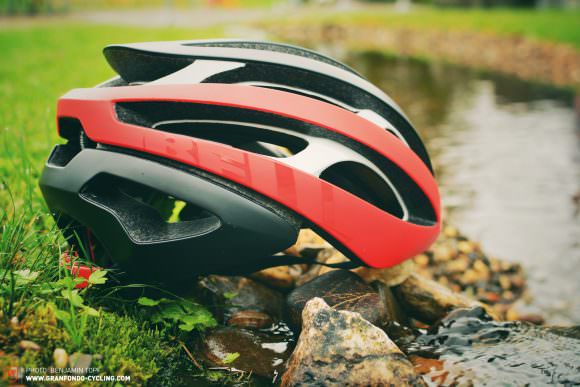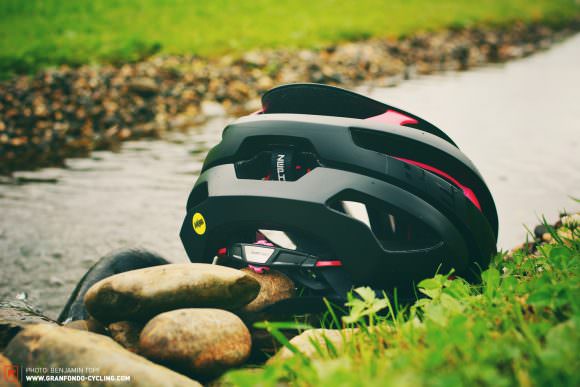The eagle-eyed amongst you may have spotted Bell’s latest lid crowning the heads of the Lotto NL-Jumbo riders at this year’s Tour de France, we thought a trip to Switzerland would be the ultimate testing ground for Bell’s top-of-the-line new helmet.
BELL´s Big Data
60 years of helmet production, thousands upon thousands of crash tests in their in-house lab, 3D scanning of countless Pro Tour athletes and those on the Moto GP circuit: drawing on much more than just the last two years of intense R&D for the Zephyr, Bell have pooled their extensive experience to design and refine a ground-breaking helmet that sets a new benchmark for the Californian company. “In terms of energy management, this is the best helmet we can currently make!” explained Bell’s product manager Sean Coffey, who was evidently pretty satisfied with the snug-fitting, MIPS-sporting, lightweight helmet.

A blank page
The ultimate helmet is one that absorbs the maximum amount of energy from a crash, rather than allowing your brain to be affected by the impact. This isn’t news though—and most definitely nothing new for Bell, who first started designing helmets in the 1950s. With the aim of crafting a pro peloton-worthy race helmet, the team at Bell unraveled all their expertise and looked closely at the fundamental criteria of a road racing helmet. Their rethink led to the so-called ‘Progressive Layering’ design, which is essentially a dual-layer construction consisting of a harder, denser EPS foam as the outer shell and a less-dense, softer inner layer. The two layers are mechanically attached and mated, rendering the need for a conventional roll cage that’s usually employed in helmet design redundant and leading to significant weight savings and improved ventilation by giving the Zephyr larger vents.
While the rotational force-dissipating MIPS layer has been taking helmet brands and their latest designs by storm, the Zephyr is the first helmet to fully integrate it in the construction. Dubbed the Float Fit Race, the MIPS layer is integrated into the retention system. Offering a novel way of adjustment, the Float Fit Race positions the micro-adjust dial slightly off the back of your head. Other than micro-adjusting the tightness, there are also four vertical settings spanning 22 mm of adjustment. Bell claim to have made major inroads with ventilation and fit on the Zephyr, granting it big vents and pressure-relieving adjustment options to the occipital pads on either side of the dial that’ll be in contact with your head. There’s also a nifty design feature at the front with a slightly longer pad to wick sweat away and direct it in front of your glasses, rather than letting it drop straight onto them and obscure your vision.

The ride
Living up to its Greek mythology namesake as the god of the west winds, there was a pretty distinct breeze in the air as we rolled out on the sinuous Swiss roads to test the Zephyr. Right from the get-go, the restyled helmet fitted snugly without any discomfort and the straps stayed close to our skin. As we rode, Bell’s product development manager Ben Penner pointed out that the Zephyr was saving us 9 watts of drag thanks to its flat-lying strap guides – so now it was just up to our legs to maximize these gains.
On the climbs, the day’s scorching 31°C made itself known and the longer pad at the front of the helmet was a godsend (perhaps from the west winds); our glasses remained smudge and sweat-free, so the wicking was clearly diverting the sweat. Our tester chose a size medium—his regular size—but bemoaned the inability to fit his race cap under the helmet, which Coffey explained is likely to down to the snugger fit from the MIPS-integrated Float Fit Race.

Hard Facts
- Hits the stores in October 2016
- 280 g for the size M
- available in S (52-56cm), M (55-59cm), L (58-62cm)
- 7 colours (black/pink, red/black, matt & gloss black, retina sear/black, blue/white, white, reflective silver/white)
- Certified standard CE EN1078
- MIPS® integrated in the Float Fit Race System
- RRP 230 €




Conclusion
Finally a Bell helmet with a refreshing new design! Although it’s neither the lightest nor the most aero helmet around, the Zephyr succeeds by being so damn unobtrusive. Over the 120 km that we clocked in the Swiss Alps, the presence of the helmet was the furthest thing from our mind, which confirms that the Zephyr is hugely comfortable and extremely well ventilated. In our opinion, the best helmets are the ones you barely notice – and that looks to be the calling card of the Bell Zephyr.
For more information, check out bellhelmets.com

Did you enjoy this article? If so, we would be stoked if you decide to support us with a monthly contribution. By becoming a supporter of GRAN FONDO, you will help secure a sustainable future for high-quality cycling journalism. Click here to learn more.
Words: Photos: Benjamin Topf, Brain Vernor







